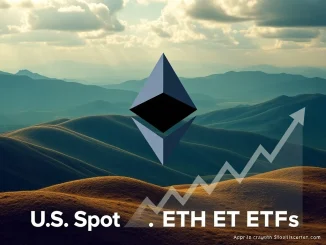
Hold onto your hats, crypto enthusiasts! The U.S. spot Ethereum ETFs market just experienced a jolt. After a period of relative calm, data from Farside Investors reveals a combined net outflow of $51.3 million on April 2nd. This marks the second consecutive day of investors pulling back from these newly launched investment vehicles. Is this a minor blip or the start of a more concerning trend? Let’s dive into the details and explore what this could mean for the future of spot Ethereum ETFs.
What Triggered the Recent Ethereum ETF Outflows?
While pinpointing the exact cause of market movements is always challenging, several factors could be contributing to these recent Ethereum ETF outflows. Let’s break down some potential reasons:
- Profit Taking: After the initial hype and inflows following the launch of spot Ethereum ETFs, some investors might be taking profits. This is a common phenomenon in any market, especially after a period of positive momentum.
- Market Volatility: The broader cryptocurrency market can be quite volatile. Uncertainty or negative sentiment in the overall crypto space, or even traditional markets, can lead investors to reduce their exposure to riskier assets like crypto ETFs.
- Specific ETF Performance: While most spot Ethereum ETFs track the price of Ethereum, slight differences in management fees or tracking error could influence investor preferences and flows between different ETFs.
- Broader Economic Concerns: Macroeconomic factors, such as inflation worries or interest rate hikes, can impact investor sentiment and lead to shifts in investment strategies, potentially away from assets perceived as higher risk.
Deep Dive into ETF Outflow Data: BlackRock ETHA and Grayscale ETHE
Let’s examine the ETF-specific data to understand where the majority of these Ethereum ETF outflows originated. According to Farside Investors, two ETFs stood out with significant net outflows on April 2nd:
| ETF | Net Outflow (April 2nd) |
|---|---|
| BlackRock ETHA | $20.2 million |
| Grayscale ETHE | $31.1 million |
As you can see, Grayscale’s ETHE experienced a larger outflow compared to BlackRock’s ETHA. It’s worth noting that Grayscale’s ETHE is a conversion of their existing Ethereum Trust, which may have different investor demographics and trading patterns compared to newly launched ETFs like BlackRock’s ETHA. The fact that the remaining ETFs reported no change in holdings suggests that the outflow is concentrated in these two funds, rather than a widespread exodus from all spot Ethereum ETFs.
Analyzing the Impact of ETHE and ETHA Outflows on Spot Ethereum ETFs
The substantial outflows from Grayscale’s ETHE and BlackRock’s ETHA raise some interesting questions about the overall health and investor sentiment towards spot Ethereum ETFs. While a single day or even two consecutive days of outflows don’t necessarily indicate a long-term trend, it’s crucial to monitor these flows closely. Here’s why:
- Market Price Pressure: Significant outflows from ETFs can, in theory, exert downward pressure on the underlying asset’s price. If ETF providers need to sell Ethereum to meet redemptions, it could contribute to selling pressure in the market.
- Investor Confidence: Sustained outflows could signal a shift in investor sentiment. It might indicate waning confidence in the near-term price appreciation of Ethereum or a broader risk-off approach in portfolios.
- ETF Market Dynamics: The performance and flow dynamics of major ETFs like ETHA and ETHE influence the perception and attractiveness of the entire spot Ethereum ETFs market. Consistent outflows could make other potential issuers hesitant or impact the overall growth trajectory of this new asset class.
Are These Outflows a Cause for Alarm?
While the $51.3 million net outflow is noteworthy, it’s essential to maintain perspective. The spot Ethereum ETFs market is still relatively new, and daily fluctuations in flows are expected. It’s crucial to look at trends over a longer period rather than reacting to short-term noise.
Actionable Insights:
- Monitor Daily Flows: Keep an eye on daily ETF flow data from reputable sources like Farside Investors to track if this outflow trend continues or reverses.
- Analyze Broader Market Sentiment: Assess the overall sentiment in the cryptocurrency market and traditional financial markets to understand potential macro factors influencing ETF flows.
- Review ETF Holdings and Performance: Compare the holdings and performance of different spot Ethereum ETFs to identify any fund-specific factors driving outflows or inflows.
The Future Outlook for Spot Ethereum ETFs Amidst Outflows
Despite these recent Ethereum ETF outflows, the long-term outlook for spot Ethereum ETFs remains potentially bright. Ethereum continues to be a leading blockchain platform with robust development activity and diverse use cases. The approval of spot ETFs provides mainstream investors with easier access to Ethereum, which could drive significant demand over time.
However, the market is still in its early stages. Understanding investor behavior, ETF flow patterns, and the interplay with broader market dynamics will be crucial in navigating the future of spot Ethereum ETFs. These initial outflows serve as a valuable reminder that even in promising new markets, volatility and shifts in investor sentiment are always part of the landscape.
In Conclusion: The $51.3 million outflow from U.S. spot Ethereum ETFs on April 2nd is a development worth watching. While not necessarily a cause for panic, it underscores the inherent volatility of the crypto market and the importance of diligent monitoring of ETF flows. Whether this is a temporary dip or the beginning of a trend remains to be seen, but staying informed and analyzing the data will be key for anyone involved in the evolving world of spot Ethereum ETFs.



